‘Queer ecology’ gifted him new perspective. Take his hikes to find it too
Los Angeles Times (archive.ph)
By Jeanette Marantos
2023-06-01 16:58:09GMT
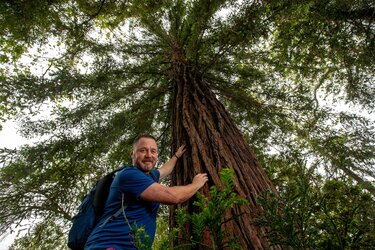
Jason Wise, an environmental science educator, is sheltered by a redwood at Griffith Park.
(Mel Melcon / Los Angeles Times)
Mother Nature kind of saved Jason “Journeyman” Wise.
Educating others about plants and the environment has given him satisfying work outdoors, far from his old career doing policy work in a windowless office.
And his ongoing nature studies have given him insights he wished he’d known years ago, as a teen in a conservative religious community near San Luis Obispo trying to deny that he was gay.
It didn’t work. It was the early 1990s, with AIDS fears swirling and his peers calling him the “F slur” no matter how hard he tried to hide his identity. Wise said he felt like a freak, afflicted, wrestling against sin as Satan whispered in his ear.
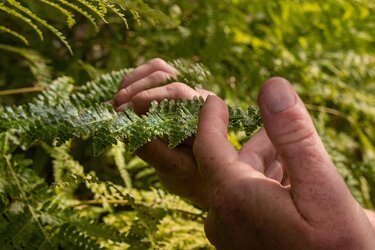
Jason Wise touches Coastal Woodfern growing at Griffith Park in Los Angeles.
(Mel Melcon / Los Angeles Times)
It might have helped, he said, if he’d known the things he knows now about queer ecology: that gender ambiguity and sexual diversity are very much a part of the natural world.
“There are so many ways of existing and creating new life on our planet ... but our cultural constructs and Western way of thinking have tried to erase those as much as possible, and put everybody in a nice little box,” said Wise, a certified California naturalist and self-described “plant nerd” based in Silver Lake.
“Just seeing examples of homosexuality in nature, for instance, might have given me a little bit of relief. Because if penguins are doing it, maybe I’m not such a bad person. Seeing it in other animals, in nature, would have felt more normal to me,” said the outdoors environmental science educator.
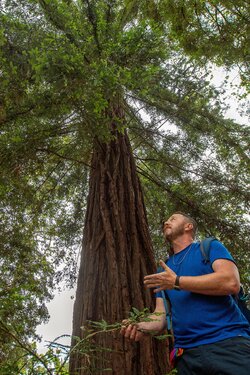
Redwood trees have male and female parts, but often reproduce asexually, says Jason Wise.
(Mel Melcon / Los Angeles Times)
Much has been written about penguins who have formed same-sex relationships — there’s even a children’s book, “And Tango Makes Three,”about the famous male couple Roy and Silo at New York’s Central Park Zoo, who performed mating rituals and then tried to “hatch” a rock like an egg until the zookeepers gave them a fertile egg another penguin couple couldn’t handle. Roy and Silo hatched the egg and raised the female chick, Tango, who went on to pair with another female penguin called Tanuzi. Meanwhile, Roy and Silo drifted apart. Roy stayed single and Silo mated with a female.
But Wise thinks butterflies are a better example of how nature deviates from our Western norms because of their many transformations, from caterpillar to a kind of goo inside a chrysalis to butterfly.
“So many young kids struggling with their identity or identifying as trans, could be comforted by the lovely metaphor of the butterfly who totally disintegrates and turns into a whole new thing,” he said. “Changing your appearance is completely natural in nature, it happens in so many ways, so why aren’t people able to do this — come out of the womb, visualize who they are and change?”
Queer ecology findings have been growing for decades, Wise said. In 2012, the student-run Yale Scientific Magazine published an article saying homosexuality had been documented in 450 species. Nearly 10 years later, the number was more than triple that when the Natural History Museum of Bern, Switzerland, opened its special 18-month exhibit “Queer: Diversity is in Our Nature” in September 2021.
The curator, Christian Kropf, a biologist at the Institute of Ecology and Evolution at the University of Bern, told swissinfo.ch — a branch of the Swiss Broadcasting System, that same-sex behavior has been observed in about 1,500 species, from dolphins to rams, “and is probably present in all social vertebrates. Many people think that homosexuality and being queer are marginal and perverse phenomena. They say they are unnatural, but this is nonsense!”
Kropf said he hoped the exhibit would fuel more tolerance in Switzerland, where the same month the exhibit opened, 64% of the nation’s voters approved same-sex marriages. “I don’t know if it contributed to the acceptance of the new marriage law in Switzerland,” he said, “but it certainly had an impact on my father. He is 87 years old and has never spoken well of homosexual people. But since he came here [to the exhibit] he has changed. He realized that same-sex behavior is absolutely normal.”
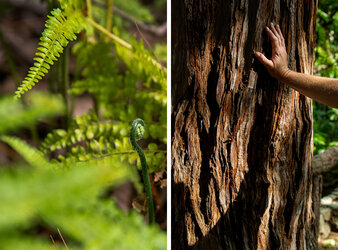
Coastal Woodfern, left, and the bark of a redwood tree, right.
(Mel Melcon / Los Angeles Times)
Wise plans to use examples closer to home when he conducts three Queer Ecology hikes this month. For instance, mallards defy norms of male dominance by putting the females in charge of picking a mate. And redwoods, like many plants, have male and female parts, but they often reproduce asexually by cloning themselves and growing new trees as “stump sprouts.”
He typically charges for his adult hikes and foraging events on weekends and evenings, but in honor of Pride Month he’s offering his Queer Ecology hikes for free on June 8 and June 29 at Griffith Park, and on June 22, in cooperation with Friends of the LA River, at Lewis MacAdams Riverfront Park in Elysian Valley. Advance registration is required to get the meeting locations, and you can find out more on Wise’s popular Instagram page, @jasonjourneyman.
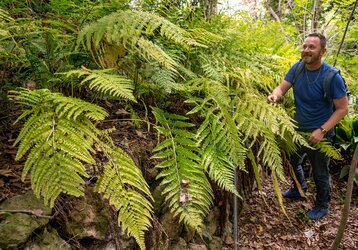
Jason Wise next to coastal woodfern growing at Griffith Park in Los Angeles.
(Mel Melcon / Los Angeles Times)
There are several other plant-related events and activities coming in June, so scroll down and start planning. If you have events you’d like to include in the garden calendar, send an email to jeanette.marantos@latimes.com by the third week of the month preceding your event, and it may be included.
Los Angeles Times (archive.ph)
By Jeanette Marantos
2023-06-01 16:58:09GMT

Jason Wise, an environmental science educator, is sheltered by a redwood at Griffith Park.
(Mel Melcon / Los Angeles Times)
Mother Nature kind of saved Jason “Journeyman” Wise.
Educating others about plants and the environment has given him satisfying work outdoors, far from his old career doing policy work in a windowless office.
And his ongoing nature studies have given him insights he wished he’d known years ago, as a teen in a conservative religious community near San Luis Obispo trying to deny that he was gay.
It didn’t work. It was the early 1990s, with AIDS fears swirling and his peers calling him the “F slur” no matter how hard he tried to hide his identity. Wise said he felt like a freak, afflicted, wrestling against sin as Satan whispered in his ear.

Jason Wise touches Coastal Woodfern growing at Griffith Park in Los Angeles.
(Mel Melcon / Los Angeles Times)
It might have helped, he said, if he’d known the things he knows now about queer ecology: that gender ambiguity and sexual diversity are very much a part of the natural world.
“There are so many ways of existing and creating new life on our planet ... but our cultural constructs and Western way of thinking have tried to erase those as much as possible, and put everybody in a nice little box,” said Wise, a certified California naturalist and self-described “plant nerd” based in Silver Lake.
“Just seeing examples of homosexuality in nature, for instance, might have given me a little bit of relief. Because if penguins are doing it, maybe I’m not such a bad person. Seeing it in other animals, in nature, would have felt more normal to me,” said the outdoors environmental science educator.

Redwood trees have male and female parts, but often reproduce asexually, says Jason Wise.
(Mel Melcon / Los Angeles Times)
Much has been written about penguins who have formed same-sex relationships — there’s even a children’s book, “And Tango Makes Three,”about the famous male couple Roy and Silo at New York’s Central Park Zoo, who performed mating rituals and then tried to “hatch” a rock like an egg until the zookeepers gave them a fertile egg another penguin couple couldn’t handle. Roy and Silo hatched the egg and raised the female chick, Tango, who went on to pair with another female penguin called Tanuzi. Meanwhile, Roy and Silo drifted apart. Roy stayed single and Silo mated with a female.
But Wise thinks butterflies are a better example of how nature deviates from our Western norms because of their many transformations, from caterpillar to a kind of goo inside a chrysalis to butterfly.
“So many young kids struggling with their identity or identifying as trans, could be comforted by the lovely metaphor of the butterfly who totally disintegrates and turns into a whole new thing,” he said. “Changing your appearance is completely natural in nature, it happens in so many ways, so why aren’t people able to do this — come out of the womb, visualize who they are and change?”
Queer ecology findings have been growing for decades, Wise said. In 2012, the student-run Yale Scientific Magazine published an article saying homosexuality had been documented in 450 species. Nearly 10 years later, the number was more than triple that when the Natural History Museum of Bern, Switzerland, opened its special 18-month exhibit “Queer: Diversity is in Our Nature” in September 2021.
The curator, Christian Kropf, a biologist at the Institute of Ecology and Evolution at the University of Bern, told swissinfo.ch — a branch of the Swiss Broadcasting System, that same-sex behavior has been observed in about 1,500 species, from dolphins to rams, “and is probably present in all social vertebrates. Many people think that homosexuality and being queer are marginal and perverse phenomena. They say they are unnatural, but this is nonsense!”
Kropf said he hoped the exhibit would fuel more tolerance in Switzerland, where the same month the exhibit opened, 64% of the nation’s voters approved same-sex marriages. “I don’t know if it contributed to the acceptance of the new marriage law in Switzerland,” he said, “but it certainly had an impact on my father. He is 87 years old and has never spoken well of homosexual people. But since he came here [to the exhibit] he has changed. He realized that same-sex behavior is absolutely normal.”

Coastal Woodfern, left, and the bark of a redwood tree, right.
(Mel Melcon / Los Angeles Times)
Wise plans to use examples closer to home when he conducts three Queer Ecology hikes this month. For instance, mallards defy norms of male dominance by putting the females in charge of picking a mate. And redwoods, like many plants, have male and female parts, but they often reproduce asexually by cloning themselves and growing new trees as “stump sprouts.”
He typically charges for his adult hikes and foraging events on weekends and evenings, but in honor of Pride Month he’s offering his Queer Ecology hikes for free on June 8 and June 29 at Griffith Park, and on June 22, in cooperation with Friends of the LA River, at Lewis MacAdams Riverfront Park in Elysian Valley. Advance registration is required to get the meeting locations, and you can find out more on Wise’s popular Instagram page, @jasonjourneyman.

Jason Wise next to coastal woodfern growing at Griffith Park in Los Angeles.
(Mel Melcon / Los Angeles Times)
There are several other plant-related events and activities coming in June, so scroll down and start planning. If you have events you’d like to include in the garden calendar, send an email to jeanette.marantos@latimes.com by the third week of the month preceding your event, and it may be included.